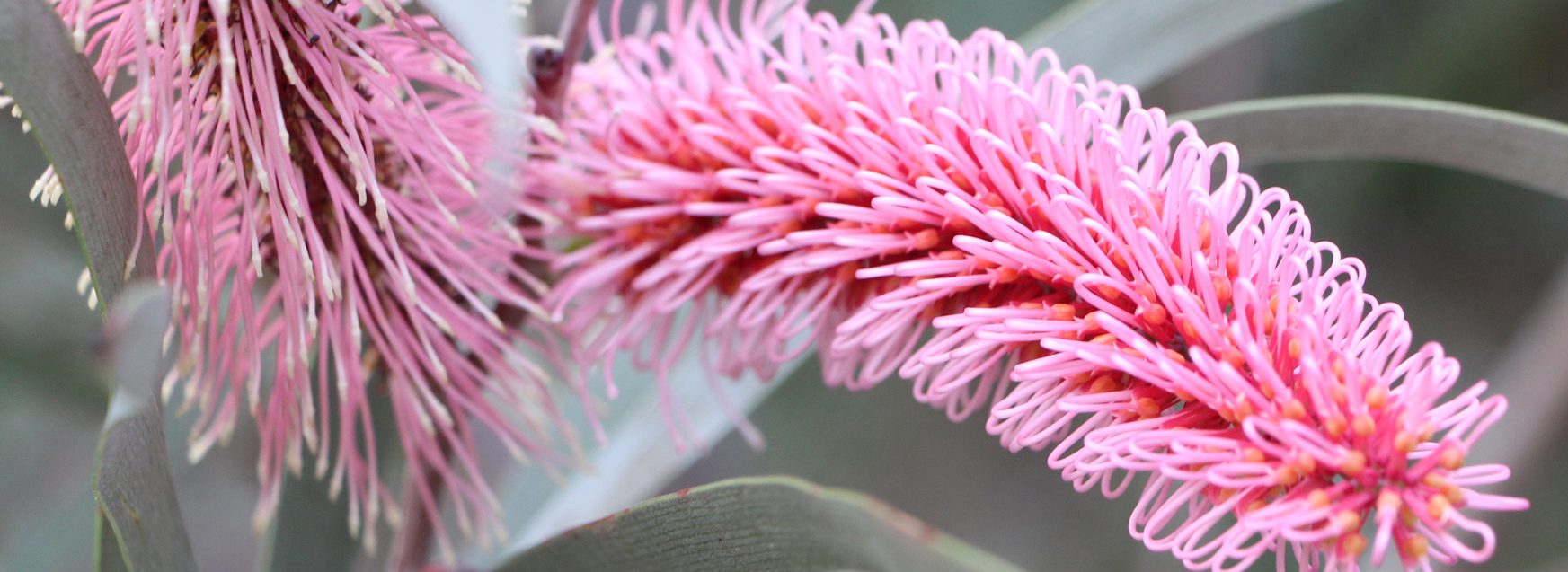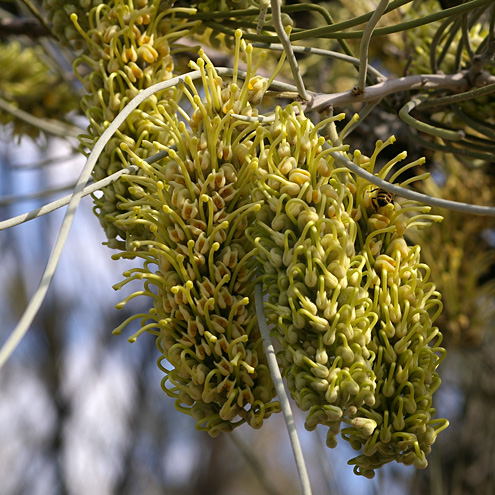Hakea – Background
Introduction
Hakea is a member of the Protea family (Proteaceae) and its close relatives include Banksia, Grevillea, Isopogon and Telopea (the Waratah). Hakea is named after Baron Christian Ludwig von Hake a German patron of botany. There are about 130 named species in the genus with a number of others which are yet to be formally described. All species of Hakea are endemic to Australia. Hakeas can be found in many different environments; the tropics, mountains, the coast and desert areas. The most diversity in the genus occurs in the south of Western Australia.
Although there are many ornamental and colourful species in the genus, Hakea has not achieved the same popularity in cultivation as its relatives Grevillea and Banksia. In some ways Hakea forms a link between those two genera having hard woody seed pods with Banksia-like seeds while the flowers occur in Grevillea-like clusters
Characteristics
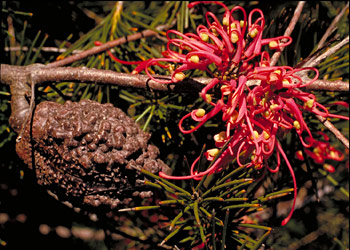 |
| Hakea bakeriana – showing the typical flowers and seed pods of the genus Photo: Brian Walters |
The flowers of Hakea species are quite small but they occur in clusters (an inflorescence) which, in some species, may consist of perhaps 100 or more individuals. The sequence of opening of each flower is similar to other members of the Proteaceae and goes through several stages:
- In bud, each flower appears as an elongated narrow tube (the perianth) comprising four segments each having an anther containing pollen at its tip.
- As the flower opens, the perianth segments separate to reveal a narrow style. Just before the flower fully opens the anthers transfer their pollen to the tip of the style (the stigma)
- Finally, the style separates from the perianth. At this stage the style and stigma, with attached pollen, is called a ‘pollen presenter’ (i.e. it is ‘presenting’ the pollen to a pollinator, usually a bird or small marsupial, which acts as the agent to transfer pollen from one flower to another for fertilisation.
This sequence is shown in the accompanying diagram (which is based on the opening of a Banksia flower).
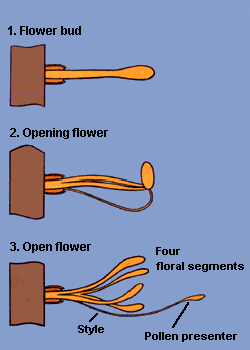
The inflorescences can be quite variable in arrangement but two that are commonly recognised are the “spider” flower arrangement, in which the flower styles arise from a rounded inflorescence like the legs of a spider (as in many grevilleas), and the “pincushion” shape where the flowers occur in a globular-shaped cluster. Another arrangement is an elongated “brush” shape where the flowers are clustered into cylindrical racemes usually at the ends of branches where they are very conspicuous.
Many (but by no means all) hakeas have stiff leaves with sharp points. This feature has probably contributed to the relatively slow uptake of the genus in general horticulture but it does make hakeas excellent plants for boundaries or places where it is desired to restrict access. It also makes them ideal plants to offer protection to birds from predators such as cats.
Hakeas generally flower in winter and spring. The flowers are followed by hard, woody seed pods each containing two seeds and, in the majority of species, these pods remain tightly closed unless stimulated to open by heat, such as following a bushfire, or by the death of the plant. The seeds themselves have a papery wing which allows them to be distributed by wind. Those species native to areas where fires occur at regular intervals often have a “lignotuber”, a woody swelling at or below ground level from which regeneration of the plant can occur if the above ground stems are destroyed.
Most hakeas are small to medium shrubs but some can reach small tree proportions. There are no truely prostrate species despite the existance of a species called H.prostrata (this may be prostrate in some forms but is commonly a small tree!). Unlike its relative Grevillea, chance hybridisation in Hakea is virtually unknown and there are few named cultivars. There is little or no deliberate breeding being undertaken with the genus.
One of the great features of hakeas in gardens is that many attract honey-eating birds which act as pollinators for the plants. A number of species rely on other methods of pollination, eg, beetles, moths, bees, ants, and even small marsupials.
Hakea – Propagation
Most hakeas are propagated by seed but vegetative propagation (eg. cuttings) is also possible. The use of grafting to extend the horticultural range of some of the spectacular species from Western Australia is becoming more common.
Seed
Seed pods are mature about 12 months after flowering when they have turned a beep brown/black colour. When removed from a plant, the pods will usually split within a week (sometimes longer) to reveal the two winged seeds. If the pods are reluctant to open, heating in an oven for about 1 hour at 125 degrees C should assist. Seed usually germinates well by conventional sowing methods in seed raising mixes although seedlings may be subject to “damping off”. To minimize this possibility, keep seeds moist but not wet. Germination should occur in 14 to 60 days, depending on the species.
Pre-germination of seed by sowing into a closed container containing moist vermiculite or a similar material is also a useful method of germinating seeds, particularly for winter sowing when outdoor temperatures may be unsuitable. Germination usually occurs in 1-2 weeks using this method and when the root has reached about a centimetre or so in length, the seedling can be placed into a small pot of seed raising mix.
Cuttings
Hakeas are not the easiest plants to propagate by cuttings but it is certainly not impossible. Cuttings about 75-100 mm in length with the leaves carefully removed from the lower two-thirds seem to be satisfactory. “Wounding” the lower stem by removing a sliver of bark and treating with a “root promoting” hormone both seem to improve the success rate.
Grafting
Because of the difficulty of growing many Western Australian species in climates of summer rainfall (see “Cultivation”), a considerable amount of experimentation has been done, at both the amateur and professional level, on grafting western species to hardier root stocks. This work has achieved considerable success to the extent where grafted hakeas are appearing for sale in nurseries.
The most commonly grafted hakeas are the so-called “grass-leaved” species including H.bucculenta, H.francisiana and H.multilineata. These are all large shrubs which have spectacular flower clusters in orange, deep pink and pink, respectively. The root stock used is almost invariably the hardy eastern Australian species H.salicifolia. Further details are under the Propagation-grafting tab.
General Propagation
Further details on general plant propagation can be found at the Society’s Plant Propagation Pages.
Grafting Hakeas
David Beardsell, David Jones and Ray Kerr
The following article is reproduced from the March 1982 issue of the Society’s journal Australian Plants. Although now some years old, the method described has been proven over the subsequent years and grafted hakeas now feature in private (and some public) gardens in many parts of Australia. Those interested should also see the article Grafted Hakea by Doug McKenzie.
Photographs illustrating grafting methods that were in the original article have not been reproduced here, but diagrams showing some of the procedures and terminology used can be found in the plant propagation by grafting section of the website.
Grafting as a method of propagation of Australian native plants has been carried out by a number of workers with mixed success (Wrigley and Fagg, 1979; Elliot and Jones, 1980). However, the only plants which are grafted commercially are Lophostemon confertus cv. Variegata and Agonis flexuosa cv. Variegata because they cannot be readily propagated from cuttings, weeping standards of Grevillea x gaudi chaudi using Grevillea robusta as a rootstock, and the nut producing species Macadamia integrifolia and M. tetraphylla.
Many species of plants from Western Australia are very difficult to grow in the eastern States, possibly due to sensitivity to the root pathogen Phytophthora cinnamomi or lack of adaptability to poorly drained and acidic soils. In a number of genera, however, there are hardy species native to the eastern States which could be used as rootstocks for these difficult species.
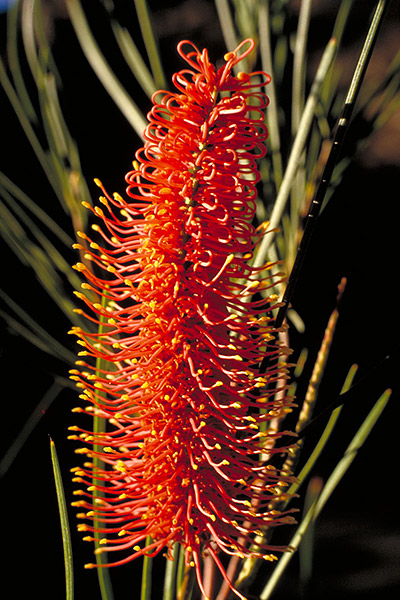 |
| Hakea bucculenta Photo: Brian Walters |
This work reports the successful adaptation of Hakea bucculenta. H.francisiana and H.multilineata to cultivation in heavy soils in southern Victoria by grafting onto Hakea salicifolia, a hardy species from New South Wales.
Materials and Methods
Young seedlings of Hakea salicifolia (syn. H.saligna) were potted into 13 cm pots and placed in a heated/cooled glasshouse in December 1975 and in December 1980, until they were actively growing with woody stems 4-8 mm in diameter (pencil thickness). In mid-January terminal shoots 6-10 cm long of Hakea bucculenta, H.francisiana and H.multilineata were taken from both young seedlings in pots grown under hard conditions outside and garden grown plants when dormant buds in the leaf axils were just beginning to swell prior to the onset of a period of active growth.
The grafts used were simple wedge (cleft) grafts, and as the scion wood was generally narrower than the rootstocks, the cambial areas (region of cell division directly under the bark) of rootstock and scion were carefully matched on one side only. The grafts were tied with grafting tape and the scion and top of the rootstock covered with a loose fitting polythene bag. The bags were left over the grafted plants for 10-14 days to help prevent drying out of the scions before union took place. If the bags were left on longer than this, buds were damaged by fungal infection. Although all leaves were removed from the scion wood in order to reduce water loss, a number of leaves must be left on the rootstock otherwise callus formation and graft union will not readily take place. Grafted plants were left in the glasshouse until the buds in the scions had produced several fully expanded leaves, approximately eight weeks after grafting. The grafted plants were then placed into a shade house for ten days of hardening off, after which they were placed into the open nursery area and the grafting tape was removed.
Using this method the percentage of successful grafts is above 80 per cent, with most failures occurring in the first two weeks after grafting.
Results and Discussion
It should be noted that although the percentage of successful grafts of the above three Hakea spp. when grafted onto Hakea drupacea (syn H.suaveolens) is also high initially, all grafts of this combination died within six months due to failure of the graft union presumably from incompatibility. Six years after grafting there have been no signs of incompatibility when using H.salicifolia as a rootstock.
The growth of grafted H.bucculenta on H.salicifolia is very vigorous, resulting in a dense attractive bush. Unfortunately it has taken six years for grafted H.bucculenta to flower. This may be because of the extreme vigour or it may be simply the result of juvenility as young seedlings were used as scions in the initial grafted plants. Flowering will probably increase in the future, while in the meantime grafted plants of H.bucculenta can be admired for their foliage and form alone. In order to increase flowering, scion wood should be taken from plants which have flowered.
In contrast, grafted Hakea francisiana flowers prolifically while still growing vigorously, forming a very attractive bush. The growth has varied where different plants were used as sources of scion wood, however, one plant which has compact growth and produces many dark pink flowers has been selected as the source of future scion wood.
Hakea multilineata when grafted onto H.salicifolia has an open, upright growth habit and is not as attractive as H.francisiana, but still forms a neat, slender tree.
Conclusion
The three species Hakea bucculenta, H.francisiana and H.multilineata, which are difficult to grow in the eastern states, can be successfully grown by grafting onto H.salicifolia. The results are good enough to encourage nurserymen to carry out grafting of these Hakea spp. on a commercial basis.
References
- Wrigley, J. W. and Fagg, M. 1979. Australian Native Plants. Collins, Sydney and London.
- Elliot, W. R. and Jones, D. L. 1980. Encyclopaedia of Australian Plants Vol.1, Lothian. Melbourne, Sydney and Auckland.
Acknowledgement: We would like to thank W. Thompson for critically reviewing this work.
Hakea – Cultivation
Hakeas are excellent garden plants although some of the species native to Western Australia may be difficult to maintain for any length of time in areas of high summer humidity and rainfall (such as the eastern coastal strip of Australia). However, experience indicates that the western hakeas are more adaptable than western banksias and grevilleas in humid areas. In fact, Hakea is generally regarded as the hardiest genus of the Australian Proteaceae. Hakeas are useful for a number of purposes in the garden and the larger species, in particular, are excellent for screening. In addition, the flowers of all hakeas produce nectar and are excellent for attracting birds.
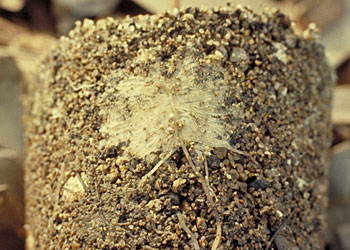 |
| A cluster of proteoid roots Photo: Brian Walters |
Like most members of the Protea family, hakeas have a distinctive root system (“proteoid roots”) consisting of tight groupings of many small “rootlets”. These are believed to enable the plants to more efficiently take up nutrients from the nutrient-deficient soils where many of the species occur naturally. In cultivation this means that the plants can be adversely affected by fertilizers, particularly phosphorus. It is generally recommended that hakeas and other Proteaceae be fertilised only with low-phosphorus, slow-release fertilisers or not be fertilised at all.
Hakeas (in common with other Australian Proteaceae) perform best in well-drained soils and generally resent continually wet soils. Shallow clay soils can present problems but if garden beds are built up to 300-600mm, greater success is experienced. Hakeas are generally at their best in open, sunny positions although the plants will tolerate some shade but probably with reduced flowering.
Also in common with other Proteaceae, a number of Hakea species are susceptible to the root rot fungus, Phytophthora cinnamomi. The most dramatic effect of Phytophthora is the sudden demise in a matter of days of an apparently healthy plant. Improvement of soil drainage is the best means of minimising attack in areas where Phytophthora is known to exist.
Hakeas respond well to regular, annual pruning where about one-third of the plant is removed. This promotes branching and produces a plant with a bushy shape. Some plants can be cut back severly if they develop a “straggly” shape but others will not tolerate this treatment. If in doubt, always leave some green foliage on the plant.
There are few serious pests that attack hakeas. Borers may occasionally be a problem but will usually be noticed by the sawdust around the entrance to their tunnels. Inserting a piece of wire into the hole will often remove the pest, or the hole can be sealed with plastic wood. A variety of other pests such as caterpillars, sooty mould and scale may appear but they are no more of a problem on hakeas than on any other plant and can often be ignored, allowing natural control methods (eg birds) to operate. If treatment is necessary, conventional pest control methods are suitable.
Hakea Study Group
The Hakea Study Group is one of a number of Study Groups within the Australian Native Plants Society (Australia). Its aim is to further knowledge about the cultivation, propagation and conservation of members of the genus Hakea. Members of the Group are mainly keen amateurs with no formal horticultural or botanical knowledge, although a number of professionals in those fields also participate.
The Study Group has been in operation since 1978 documenting reports from members into cultivation issues, propagation methods and natural occurrences of different species. These reports have assisted in assessing the suitability of various species for cultivation in a range of climatic zones.
Further information about the Study Group, its activities and access to the newsletter archive can be found at the link below.
Hakea – Further Information
Most books dealing with Australian native plants will contain useful information on the botany and horticulture of hakeas. Some of the most detailed references are listed below.
Books:
- Elliot W R and Jones D (1990), The Encyclopaedia of Australian Plants, Vol.5, Lothian Publishing Company Pty Ltd, Melbourne.
- Holliday I (2005), Hakeas: A Field and Garden Guide, Reed New Holland, Sydney.
- Raleigh R (1996), Hakea, Identification booklet prepared for Hakea Weekend, October 1996, SGAP Victorian Region and Wimmera Growers of Australian Plants.
- Wrigley J and Fagg M (1989), Banksias, Waratahs and Grevilleas, Collins Publishers Australia.
- Young J A (2006), Hakeas of Western Australia: A Field and Identification Guide, published by the author.
Journals:
Several issues of the Society’s journal “Australian Plants” are particularly useful for those interested in Hakea.
- Vol 7, No 59 June 1974; Descriptions of many species; The Hakea multilineata group.
- Vol 8, No.67 June 1976; Detailed description of the botany, biology and distribution of the H.sulcata group; Description of H.bakeriana.
- Vol 9, No.72 September 1977; Descriptions of eastern species with photographs.
- Vol 11, No.90 March 1982; Research into grafting of Western Australian species.
- Vol 21, No.165 December 2000; Growing Hakea; Spectacular Hakea; More research into grafting of Western Australian species
Internet:
- Australian Hakea species: identification and information by Robyn Barker. An interactive web-based key for all presently known species of Hakea.
- Burrendong’s Hakeas – One of the great success stories at Burrendong Arboretum is the Hakea collection
- Grafted Hakea
- Growing Native Plants – a series of plant profiles by the Australian National Botanic Gardens; includes a number of hakeas.
- Hakeas – Characteristics and Cultivation Methods
- Have a Hakea – from Ian Fraser’s ‘Talking Naturally’ blog, a brief introduction to a genus with numerous photos.
 Australian Native Plants Society (Australia)
Australian Native Plants Society (Australia)